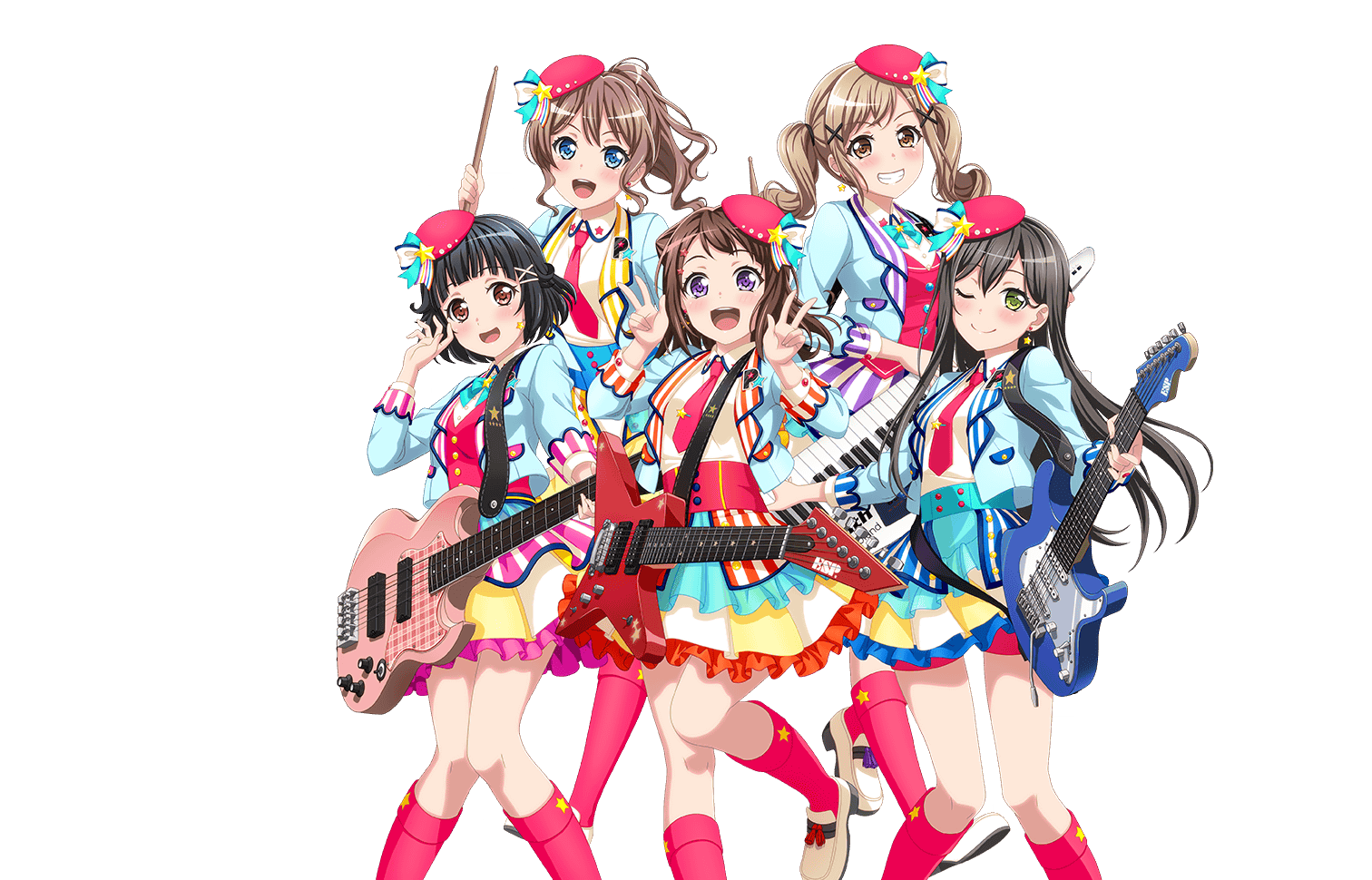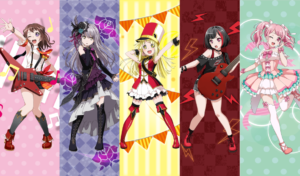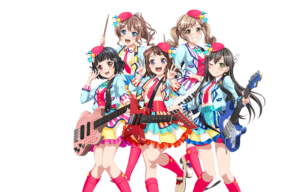
Poppin’Party was first made known in 2015 as Bushiroad’s multimedia mix IP under Bang Dream. The initial poor reception prompted a facelift in 2017 with upgraded visuals when releasing the smartphone game Bang Dream Girls Band Party. Since then, Poppin’ Party came a long way since its beginning and is now active with their motivating band performances.
From the original franchise, Poppin’ Party centers around Kasumi, the main Vocal, with her desire to chase for that sparkling heart pounding beat. Kasumi’s obsession with stars is symbolized well with the unique skill of the deck, which revolves around Critical Triggers.
Card Introduction
Grade 3

The main G3 for the deck. The first skill requires gathering all the Poppin’ Party band members. When all of them are gathered, any trigger effects given to itself will be given to all Front Row rearguards. This effect is similar to Zeroth Dragon Ultima, which gave its trigger effects to all units. It’s powerful as the deck looks to drive check Criticals, giving 3 threatening attacks.
Its second skill can play any Poppin’ Party music from either the drop zone or the deck. It helps activate the Order effects, which are key to the deck.
Grade 2

This Kasumi is simple, a chance to get a music card from the top 7 cards of the deck. Music Order cards are an important part of the deck so a chance to add it to hand is useful.

Tae can help pickup a music card from the drop zone by discarding 1, useful when there is no Counterblast available for Glittering Stage Kasumi, or looking for specific orders to use.
Her 2nd skill helps power up the Vanguard and itself when the Vanguard Attacks. Helps increase column numbers.

Rimi’s skill is to give the Vanguard +10k power/+1 drive with a discard 1 and revealing a Critical when the opponent is Grade 3 or above. It helps increase the chance of drive checking more triggers which synergises with Glittering Stage Kasumi’s skill.
Grade 1

This Kasumi serves as a great Grade 1 ride target, able to search the top 7 card of the deck for Sparkling Stage Kasumi.
Her rearguard skill helps pick up other Poppin’ Party members other than itself from the drop zone, which helps gather the band members.

Arisa’s skill is to find other Poppin Party members other than herself. A simple and strong skill to help consistently gather the band members

Saya’s skill is to help pick up the members of Poppin Party from the drop zone. By CB1 and returning a card back to the bottom of the deck, the player can take 1 Poppin Party member and a Critical from the drop zone and add them to the hand. It can return a trigger back to the deck, which increases the odds of a trigger chance later and also adds a critical trigger from the drop zone, which is used as a cost in various other cards in the deck.
Music Order Cards
Order cards is the newest mechanic in Vanguard. Order cards can only be played once every turn and for Bang Dream, these (music) Order cards will be placed on the rearguard circle behind the Vanguard Circle and moved into the drop zone at the end of the turn. These Order cards have grades, which can only be played if the Vanguard is of the same grade or above.

The 2nd Band Story song for Poppin Party.
In Vanguard, by playing it you will draw 1 and look at the top 3 cards for a Critical to add to hand. This helps with activating the card effects that requires revealing a Critical Trigger.
This music is less powerful compared to the other 2 and is only best played on your Grade 1 or Grade 2 turns.

Opening song for the 2nd Season of the Anime.
In Vanguard, this card has 2 skills
1. A simple power boost that helps increase the amount of shields required from the opponent.
2. A skill to help gather all the Poppin’ Party members
This music is the most commonly played music to gather all the members for Sparkling Stage Kasumi’s skill. Be careful about the soulblast cost as it might clash with Arisa’s skill.

Insert song for 2nd Season of the Anime.
By gathering all the Poppin Party members at the start of the battle phase, reveal the top 5 cards of the deck. Any Critical Triggers among the revealed cards give all members +5k power and also 1 of them is placed on top of the deck.
This music is best played when all the members are gathered as it could power up the board more than Kizuna Music and could guarantee a Critical Trigger for Glittering Stage Kasumi’s drive check.
Gameplan
Poppin’ Party has a simple field setup that is replicated every game.
It is an easy to remember setup, by gathering all the members, calling them onto the rearguard circles and using a Music Order. For current players this deck is similar to that of Messianic Lord Blaster, which requires 6 different blaster units on the field. This deck’s aim is gathering all the Poppin’ Party members for Sparkling Stage, Kasumi and getting the trigger effects spread to front row rearguards, with the skills of the other members help gather them all.

Force I vs Force II
This question of which Force marker and where to place the Force marker is a question that most Force decks have. With this deck, there are the music orders, which means there is normally no booster for the Vanguard. The natural choice will be to choose Force I and place it on the Vanguard circle, and if any extra Force markers are created, place them on the Rearguard Circle.
The power of Force II marker is not to be underestimated in this deck, as it could mean 3 Critical attacks to the opponent. But that means the power of the attacking units are reduced and the opponent could guard it easily. Do gauge the current game state before deciding to take Force II as it could lose a winning game as Force II attacks can be easily guarded by opponents.
Sample Decklists
Generic List

4 of each Poppin’ Party unit available, and 5 music cards. The order lineup aims to keep a Music card on the field every turn if possible, aiming to get Double Rainbow at G1 turns and Kizuna Music in Grade 2 turns. With Sparkling Stage Kasumi, Returns can be searched out from the deck or be used from the drop zone when needed. The main reason for minimizing orders is that the orders are worth 0 shield and is mainly useless in guarding, as from Grade 3 turns Sparkling Stage Kasumi is the main way to play Music each turn.
Altered List

As the main units cant be changed much, the trigger lineup and music order counts are the cards that can be changed. This is a more aggressive variant that gives up draw sentinels for critical triggers, increasing the chances to drive check more critical triggers. 1 Overflowing Execution Kasumi and Double Rainbow are cut for more Kizuna Music and Returns
With the increased criticals, 4 Kizuna Music is played as the deck is more reliant on gathering all the members by the Grade 3 turn and increasing the odds to draw Kizuna Music by Grade 2 turns help with that. 2 Returns is to not brick when 1 copy gets stuck in the damage zone.

This is an example of an altered topping list. Again Double Rainbow is cut due to being underwhelming but sacrificing heals for more criticals is doable as the deck is likely to be ahead in damage and heal triggers are unlikely to activate the healing 1 damage from your damage zone.
Conclusion
Kasumi’s obsession with stars had its flavor converted well into Vanguard, chasing the star on Critical Triggers. It may be reliant on maintaining the full field, but the Ultima-like effect from Sparkling Stage Kasumi and the obession with checking criticals should be a great reason to choose Poppin’ Party as the deck from this set. Besides being an oshi (fan) of the band of course!




